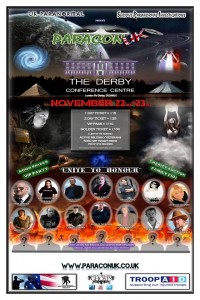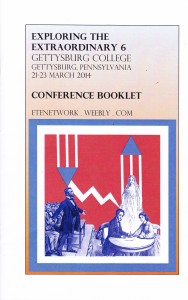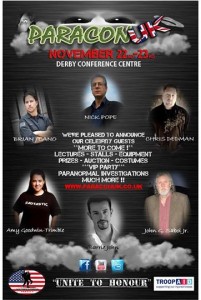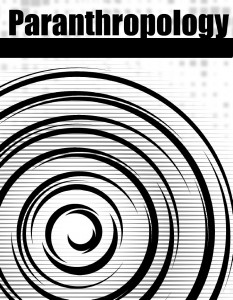 |
| Slideshow customized with SmileboxGavin DeGraw – Soldier (Audio)
|
Cover credit: Andy Sharp
Reviews of John Sabol’s presentations at the following links:
Re-Constructing a Haunted Space
How should we explore and document the past at a haunted location? How can we construct knowledge from ephemeral and trace presences? We must begin with practices that have meaning in the past, not popularity in the present! We must appreciate (and understand) that some remains of the past that manifest do form part of a social world that is still present, and not “paranormal”!
We must avoid any strict conception as to what type of fieldwork this should (or should not) be. We must, though, involve ourselves with social re-construction in these spaces, putting manifestations into past (not present) cultural context. We must devise means and tools which enable us to be both sensitive to a past sociability, and be ethical in the process.
By definition, the past cannot be present. That it is (and we see it all around us in architecture, music, dress, etc.) does not make its presence something one considers as “paranormal”. A past has been completed, but other vestiges, traces, residuals, and remains of particular (some biographical) elements of the past still “live on” today. This existence of past presence is not an alternative or parallel universe. It is reality, albeit contemporary archaeological reality (“ruins”) in some instances.
Ghost research, like archaeology, must not be mere observational work (“ruined vistas”), or an observation of what is “excavated”. Likewise, in ghost research, it is not merely the observation of what the instruments are measuring, the monitor is displaying, or the audio is recording (many times in absencia). It must become, first, a participatory practice. We must participate to observe what may be left of the past in particular spaces.
This participatory stance, however, must not be reduced to the status of entertainment, or as a spectacle of excess (an “extreme paranormal” stance). It must be, and remain, contextual, a performance that is rooted to an event (or activity) in the past; or, to a particular biographical past of a known individual, one known to have occupied that “haunted” space (or produced some act there). This participatory-ethnographic trope is the basic premise of a “ghost excavation”. It is how we begin our re-construction of haunted space.
Cultural Identity: The “Missing Link” In Ghost Research Sociability
In today’s modern world, through the venue of social media, there is a new landscape social setting in which people, communities of followers, and cultures (both popular and scientific) mix. This communicative and interactive (interactional) network (and networking) has created an alternative inter-cultural contextual reality, linking geographical spheres (horizontally) to multiple temporalities, both past and present (vertically). Existing cultural identities, once thought firmly grounded, have attained liminal roles in this global mix. Today, the internet fosters this particular liminal social identity by imposing a new perception of time and space, providing new meanings to “what” and “who” becomes popular, as internet links and pages re-define power and influence, attaching it to the importance of a “popularized” social identity.
This has also led to a shift in contemporary individual consciousness and historical “afterlife” conscious manifestations. The process of globalized communication has increased the perception of haunted space, and interactions with various forms of past presences once thought to be dead and buried. The “hunt” for “ghosts, in this spectral turn, also bring with it a cultural “badge” of identity, acts that define contemporary, not past, behaviors and technology. This has created an “identity crisis” in ghost research today. It is the result of the popular cultural trope of behaviors seen on paranormal reality TV programming, on “ghost hunts”, at “para-celebrity” events, and through social media. The search for a “legitimate identity”, attached to serious fieldwork, has been lost to entertainment and economics.
This is not all that “haunts” contemporary ghost research. A “ghost hunting” identity and mentality, with its stereotype “wardrobe” and “standardized” field acts, has become the basis of a popular individual and collective identity that certainly impedes the cultural understanding of a haunting, and the various means of communicating with interactive past presences. Unfortunately, the concept of “belonging” has become identified with this “ghost hunt” identity and mentality.
In a “ghost excavation”, we do not follow this “ghost hunt” identity. We “perform” to the past, and not the “audience” of the present. On these pages is a small sampling of what we do, hoping to change this “ghost hunt” mentality to a different cultural “identity”, one that resonates with those of the past with whom we are attempting to communicate with, by becoming a part of their continuing social world. Please review our site, and continue to drop by from time to time, as we update the site.
Paranthropology, Vol 4, No. 3 (July 2013)
Article: “The Culture of War, ‘Afterlife Conscious Minds,” & Morphogenic Fields: The Past Soundscapes of an American Civil War Battlefield”, Author, John Sabol, pages 41 – 47
Most of us who seriously investigate haunted space are aware of the resonances and associations that are popularly-connected to that space by others. Knowing is one thing, but participating in it is another! Serious fieldwork must remain separate from these popular tropes. The analysis of the production of past space, and what remains after the event, like archaeology, is the concern of serious fieldwork.
A field investigator must separate an analysis of this production from the consumption of haunted space made by ghost tour operators and para-event promotors. The serious investigator deals with the real past, the source and production of space-making, not spatial entertainments.
It is not within the field of serious research to deal with (or be involved in) this popular consumption of the “paranormal”, its commercial use in “ghost tourism”, or popular reality TV shows that entertain not educate. These manifestations of contemporary popular entertainment are pre-conceived notions belonging to the present and are immersed in economics, not research. Such responses to the popularity of the paranormal treat the presence of the past as a commercial resource for present consumption, purpose, and interest.
Serious ghost research, a concern with the production of haunted space, is meant as a source of knowledge acquisition. Let’s relieve ourselves from the popular, commercial, sentimental, and subjective responses of “ghost hunting”. Let’s separate them from professional and serious study. We must maintain this relevance, and to make that relevance accessible and acceptable to academia. To do otherwise, would be a great injustice to those who still remain after the events in their lives have ended, some perhaps long ago. To think, act, and work with what remains in that subjective and entertaining mode has little to do with what (and who) may actually remain of the past in haunted space. Let’s just focus on the past itself in those spaces considered haunted by lingering presences!




